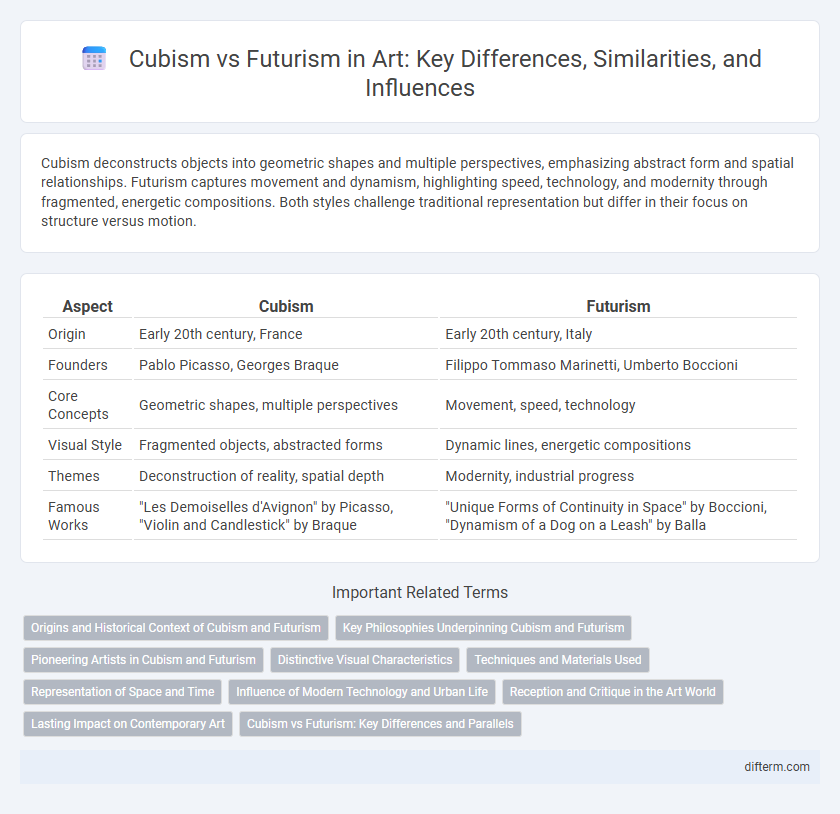Cubism deconstructs objects into geometric shapes and multiple perspectives, emphasizing abstract form and spatial relationships. Futurism captures movement and dynamism, highlighting speed, technology, and modernity through fragmented, energetic compositions. Both styles challenge traditional representation but differ in their focus on structure versus motion.
Table of Comparison
| Aspect | Cubism | Futurism |
|---|---|---|
| Origin | Early 20th century, France | Early 20th century, Italy |
| Founders | Pablo Picasso, Georges Braque | Filippo Tommaso Marinetti, Umberto Boccioni |
| Core Concepts | Geometric shapes, multiple perspectives | Movement, speed, technology |
| Visual Style | Fragmented objects, abstracted forms | Dynamic lines, energetic compositions |
| Themes | Deconstruction of reality, spatial depth | Modernity, industrial progress |
| Famous Works | "Les Demoiselles d'Avignon" by Picasso, "Violin and Candlestick" by Braque | "Unique Forms of Continuity in Space" by Boccioni, "Dynamism of a Dog on a Leash" by Balla |
Origins and Historical Context of Cubism and Futurism
Cubism originated in the early 20th century, pioneered by Pablo Picasso and Georges Braque in Paris, emphasizing fragmented forms and multiple perspectives rooted in African and Iberian art influences. Futurism emerged slightly later in Italy, led by Filippo Tommaso Marinetti, celebrating modernity, speed, technology, and industrial development as reflected in dynamic, aggressive compositions. Both movements reacted against traditional artistic norms but diverged in their thematic focus: Cubism deconstructed reality into abstract shapes, while Futurism glorified movement and progress amid rapid societal changes.
Key Philosophies Underpinning Cubism and Futurism
Cubism centers on deconstructing objects into geometric forms and presenting multiple perspectives simultaneously to challenge traditional representation and embrace abstracted reality. Futurism emphasizes dynamism, speed, and technological progress, portraying movement and the energy of modern life to celebrate innovation and reject the past. Both movements revolutionize visual experience by breaking conventional artistic boundaries, with Cubism focusing on analytical fragmentation and Futurism on kinetic force.
Pioneering Artists in Cubism and Futurism
Pablo Picasso and Georges Braque pioneered Cubism by deconstructing objects into geometric forms and multiple perspectives, reshaping modern art's approach to space and form. Meanwhile, Filippo Tommaso Marinetti and Umberto Boccioni spearheaded Futurism, emphasizing dynamic movement, speed, and the energy of industrialization through fragmented shapes and vibrant compositions. Both movements radically transformed artistic expression in the early 20th century, influencing abstract art and challenging traditional representation.
Distinctive Visual Characteristics
Cubism emphasizes fragmented, geometric shapes and multiple perspectives within a single plane, resulting in abstract, faceted forms that challenge traditional representation. Futurism captures dynamic movement and speed through blurred lines, overlapping forms, and vibrant color contrasts, reflecting modernity and technological progress. Both movements revolutionize visual perception but differ in their focus on static spatial analysis versus kinetic energy and motion.
Techniques and Materials Used
Cubism employed fragmented geometric shapes and multiple perspectives to depict subjects, primarily using oil paints on canvas and incorporating collage with newspaper clippings and textured materials. Futurism emphasized dynamic movement and the depiction of speed through bold lines, vibrant colors, and the use of mixed media including metal, glass, and industrial materials. Techniques in Futurism often involved repeated forms and blurred outlines to simulate motion, contrasting with Cubism's analytical deconstruction of form.
Representation of Space and Time
Cubism fractures space into geometric planes, presenting multiple perspectives simultaneously to challenge traditional spatial representation. Futurism emphasizes dynamic motion and the passage of time by depicting sequential movement and speed within a single image. Both movements revolutionized visual art by rejecting static representation, but Cubism deconstructs space while Futurism captures temporal flow.
Influence of Modern Technology and Urban Life
Cubism deconstructs objects into geometric forms, reflecting the fragmented perspective of modern urban life influenced by technological advancements such as photography and film. Futurism embraces speed, machinery, and industrial progress, capturing the dynamic energy of cities transformed by automobiles, trains, and electric lighting. Both movements emphasize the impact of early 20th-century technological innovation and urbanization on artistic expression.
Reception and Critique in the Art World
Cubism, pioneered by Pablo Picasso and Georges Braque, was initially met with confusion but eventually celebrated for its revolutionary approach to depicting multiple perspectives within a single plane, profoundly influencing modern art. Futurism, led by Filippo Tommaso Marinetti, emphasized dynamism, technology, and movement, receiving both acclaim for its bold energy and criticism for its aggressive rejection of tradition and association with political ideologies. The art world has since recognized Cubism's foundational role in abstract art, while Futurism remains notable for its impact on visual culture and design despite controversies.
Lasting Impact on Contemporary Art
Cubism revolutionized contemporary art by introducing fragmented perspectives and abstract forms that challenged traditional representation, influencing movements like abstract expressionism and modern design. Futurism's emphasis on dynamism, speed, and technology inspired later artists to explore motion and industrial themes, shaping kinetic art and multimedia installations. Both movements fundamentally transformed visual language, encouraging innovation in the portrayal of space and time.
Cubism vs Futurism: Key Differences and Parallels
Cubism and Futurism both revolutionized early 20th-century art by challenging traditional perspectives, with Cubism emphasizing fragmented, geometric forms and multiple viewpoints, while Futurism captured dynamic movement and the energy of modern technology. Cubist artists like Pablo Picasso deconstructed objects into abstracted planes, whereas Futurists such as Umberto Boccioni conveyed speed and mechanization through fluid, overlapping shapes. Despite their differences, both movements influenced the evolution of modern art by breaking away from realistic representation and embracing abstraction.
cubism vs futurism Infographic

 difterm.com
difterm.com